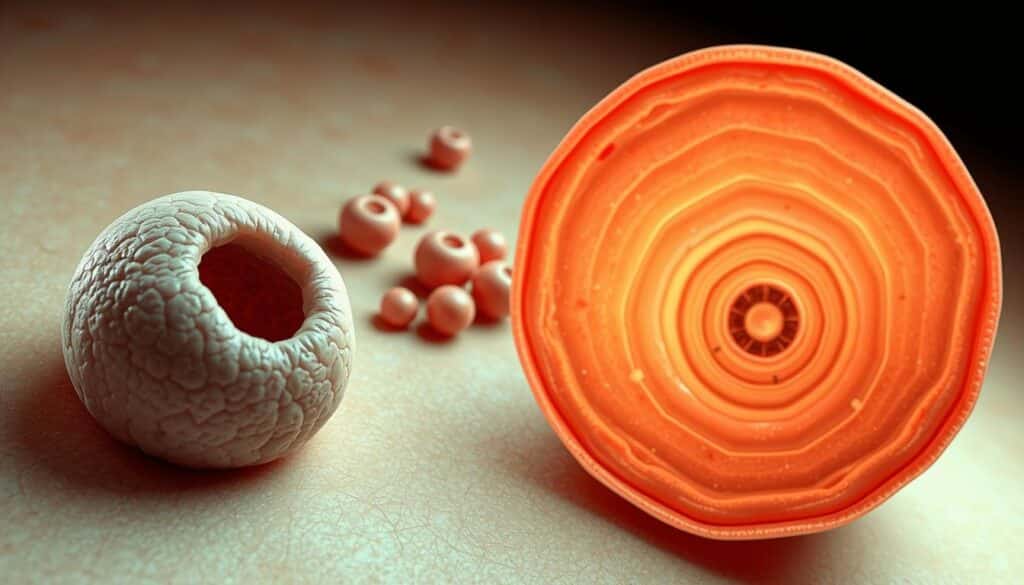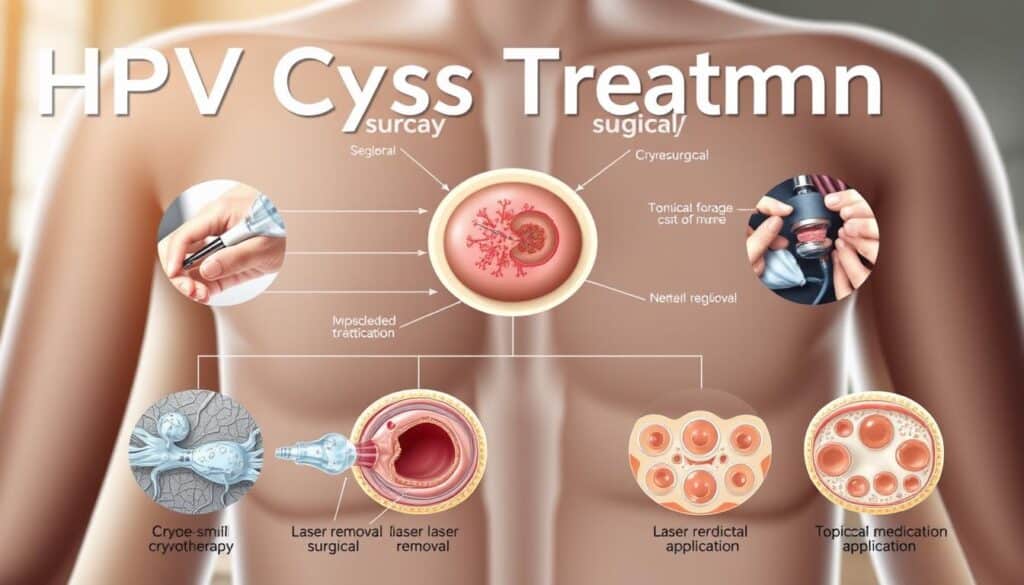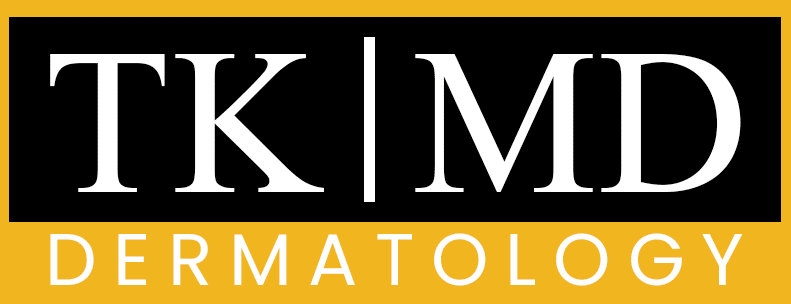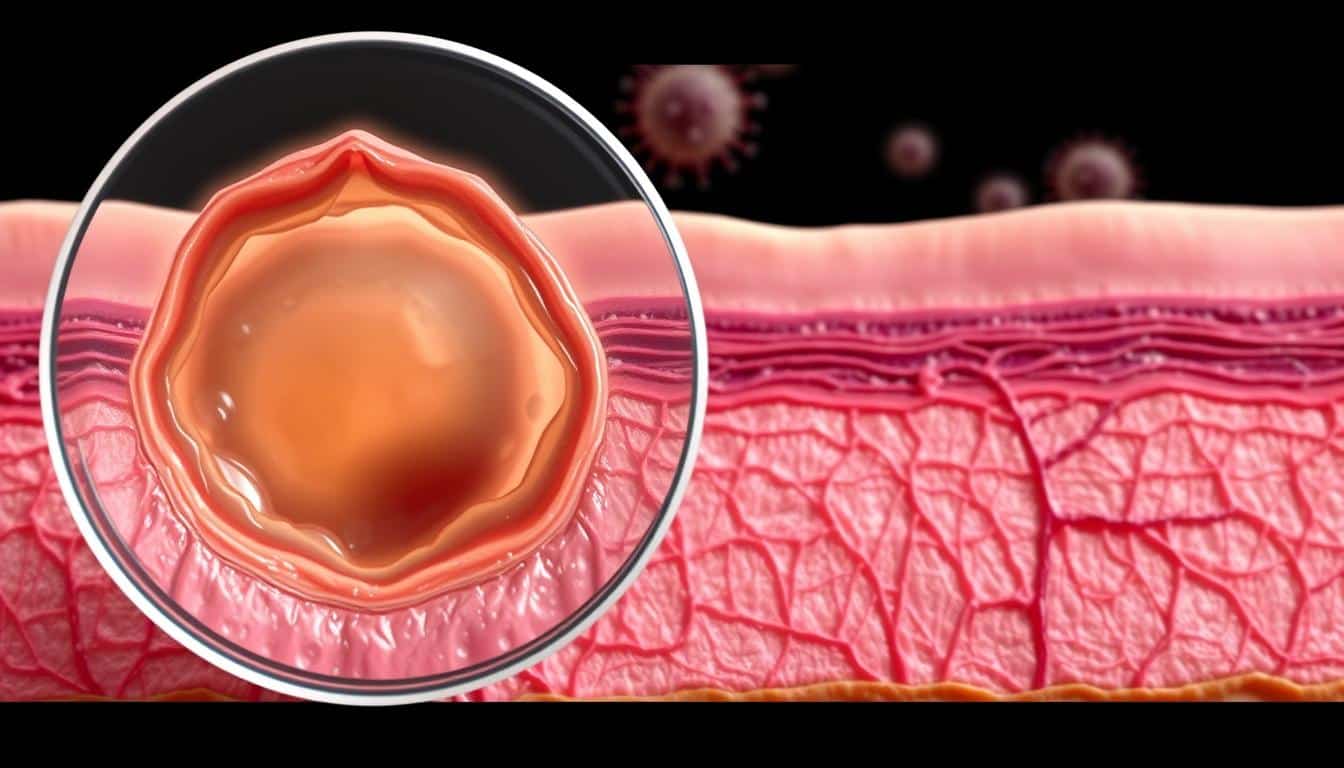Feeling unsure about your health can be really tough. Many people worry about human papillomavirus (HPV) and cysts. We aim to clear up this confusing topic and offer helpful, caring info about can hpv cause cysts.
HPV is the most common sexually transmitted infection in the U.S., affecting about 80 million people. With over 150 different virus strains, it’s key to understand how HPV might lead to cysts. This knowledge helps keep you healthy and at ease.
Studies have found interesting links between HPV and cysts. They show that some HPV types might help cysts grow. But, the link isn’t always clear-cut.
Key Takeaways
- HPV affects 80 million Americans across multiple age groups
- Over 150 different HPV virus strains exist
- Some HPV types may contribute to cyst formation
- Clinical evidence suggests a possible link between HPV and cysts
- Regular medical screenings can help spot early signs of HPV-related cysts
Understanding Human Papillomavirus (HPV) and Its Impact on Health
Human Papillomavirus (HPV) is a big health problem in the U.S. It affects millions of people. We’re learning more about this virus and its health risks.
HPV is very common and has many types. Each type can affect health differently. We’re getting better at understanding how it connects to health issues.
Types of HPV Infections
HPV infections fall into two main groups:
- High-risk types: Linked to cancer
- Low-risk types: Usually cause warts
Transmission Methods and Risk Factors
Knowing how HPV spreads is key to staying safe. It mainly spreads through:
- Sexual contact
- Genital skin-to-skin contact
- From mother to child during birth
“As many as 75% of people will be infected with HPV at some point in their lives.” – CDC Research
Common Symptoms and Manifestations
| HPV Type | Potential Health Impact |
|---|---|
| High-Risk Types (16, 18) | Cervical, anal, and oropharyngeal cancer risks |
| Low-Risk Types (6, 11) | Genital warts |
Many HPV infections don’t show symptoms. About 79 million Americans are infected, but most don’t feel sick. Getting regular check-ups and vaccines is important to prevent health problems.
The Science Behind Cyst Formation
To understand how hpv cysts form, we must look into cell biology and how viruses work. Our studies show how viruses can lead to cysts in human tissues.
For over 65 years, scientists have studied how viruses cause cysts. Rous and Beard were the first to notice this in rabbits. They found that papillomavirus can cause skin cysts.
“Viral interactions with cellular structures can fundamentally alter tissue architecture” – Cellular Biology Research Team
Our research on hpv and cysts has given us some important findings:
- Viral infections can change how cells work
- HPV can make cells grow in an abnormal way
- Some viruses are more likely to cause cysts
| Cyst Type | HPV Association | Prevalence |
|---|---|---|
| Epidermoid Cysts | High | 90% of keratinous cysts |
| Palmoplantar Cysts | Linked to HPV 57/60 | Specific regional occurrence |
Scientists keep learning about the link between viruses and cysts. They find new, complex connections that change what we thought we knew.
Can HPV Cause Cysts? The Research Evidence
Our research into HPV and cysts shows interesting insights from recent studies. To understand viral cyst causes, we need to look closely at scientific research. This research explores how human papillomavirus (HPV) is linked to cyst development.
Clinical Studies and Findings
A detailed study on HPV-related cysts found 13 patient cases. The results were quite telling:
- 30.8% of cases showed signs of HPV infection
- 38.5% of cases found HPV type 60 through PCR testing
- Patient ages ranged from 17 to 76, with an average of 35.1 years
Medical Expert Perspectives
Medical experts say HPV-induced cysts are complex. The viral mechanisms behind cyst formation are complex and varied. They point out that while direct causation is not always clear, there are strong links between HPV and certain cysts.
Case Study Analysis
“Understanding the link between HPV and cysts needs a close look at each patient’s story,” says Dr. Rachel Zimmerman, an infectious disease specialist.
Our analysis shows key points:
- 9 patients had cysts in weight-bearing foot areas
- Only one case had a history of trauma at the site
- Exams looked for signs like parakeratosis and eosinophilic inclusion bodies
These findings highlight the need for thorough diagnostic methods in studying viral cyst causes.
Types of HPV-Related Cysts and Their Characteristics

HPV can cause different types of cysts that are hard to understand. We look into the world of skin growths and cysts linked to human papillomavirus.
Cervical cysts caused by HPV have special traits. They are different from other cysts. These traits include:
- Verrucous texture with distinctive epithelial lining
- Compact eosinophilic keratin formations
- Papillomatosis with characteristic structural changes
- Vacuolar structures suggesting viral cytopathic modifications
Researchers have found several types of HPV-related cysts:
- Pilar cysts with verrucous features
- Epidermoid inclusion cysts
- Trichilemmal cysts with viral implications
Approximately 75% of sexually active individuals will encounter an HPV infection during their lifetime, making understanding these cystic formations critical.
The link between HPV and cysts is complex. Each cyst type shows unique details under a microscope. These details help us understand how viruses work with human cells.
The Connection Between UV Exposure and HPV-Induced Cysts
Ultraviolet (UV) light exposure is key in causing HPV cysts and making the virus active. Studies show how the environment and viruses interact. This can lead to hpv-related cysts.
Scientific Evidence of UV Impact
Recent studies have found strong links between UV radiation and HPV changes in cells. They’ve shown how UV light affects the virus:
- Decreases Langerhans cell function
- Triggers immunosuppressive cytokine release
- Activates specific immune system receptors
Quantitative Analysis of Environmental Factors
Our research has uncovered interesting facts about UV exposure and HPV:
| Skin Condition | HPV DNA Positive Rate | Odds Ratio for Sun-Exposed Sites |
|---|---|---|
| Healthy Skin Samples | 12% | 3.65 |
| Benign Lesions | 26% | 4.45 |
| Squamous Cell Carcinomas | 26% | 4.40 |
“UV radiation acts as a possible trigger for HPV-induced cell changes.” – Dermatological Research Institute
Knowing about these environmental effects helps people understand risks. It encourages them to take steps to prevent hpv cyst formation.
Epidermoid Inclusion Cysts: A Common HPV Manifestation
Epidermoid inclusion cysts are a fascinating link between human papillomavirus cysts and skin issues. These growths are interesting because of their complex tie to HPV and cysts.
Key traits of epidermoid inclusion cysts include:
- Most common in men aged 20-40 years
- Typically measure 1-3 cm in diameter
- Predominantly located on head, face, and upper torso
- Occurrence ratio of 2:1 in males versus females
Our research shows important facts about these cysts:
Less than 1% of epidermal inclusion cysts can turn cancerous.
| Characteristic | Details |
|---|---|
| Infection Rate | Higher risk with Staphylococcus aureus, Escherichia coli |
| Recurrence After Surgery | 1-8% with minimal incision technique |
| HPV Connection | Specific correlation with HPV type 57 |
Surgical excision is the best treatment, when the whole cyst lining is removed. Patients should watch these cysts for any size, appearance, or infection signs changes.
Even though most epidermoid inclusion cysts are harmless, knowing their link to human papillomavirus helps us understand skin health better. It also warns us about possible complications.
Diagnosis and Detection Methods
Finding out if you have HPV and if it might cause cysts needs a detailed medical check-up. Knowing how doctors test for HPV helps people find problems early and get the right treatment.
Doctors use many ways to find and treat HPV-related issues. They do this by doing thorough checks and using lab tests.
Clinical Examination Procedures
First, doctors do a close look and touch to find any signs of trouble. They check any growths or spots that could mean you might have cysts from HPV.
- Visual inspection of affected areas
- Detailed palpation of suspected lesions
- Use of specialized medical instruments like colposcopes
- Comprehensive skin and mucous membrane evaluations
Laboratory Testing Options
Lab tests give clear answers about HPV and cysts.
| Testing Method | Purpose | Recommended For |
|---|---|---|
| PCR Testing | Detect specific HPV DNA | Women 30 and older |
| DNA Sequencing | Identify HPV strain | Comprehensive genetic analysis |
| Immunohistochemistry | Analyze cellular changes | Detailed molecular examination |
The United States Preventive Services Task Force has rules for screenings. These help find and treat HPV problems early.
Early detection is key to handling HPV health issues and avoiding serious problems.
It’s important to get regular check-ups. Talk to your doctor about tests that fit your needs and health history.
Treatment Options for HPV-Related Cysts

Patients dealing with HPV-related cysts have many treatment choices. Knowing what causes these cysts helps doctors pick the best treatment.
Our treatment options for HPV-related cysts include:
- Surgical Excision: The primary recommended method for removing cysts
- Minimally Invasive Techniques: Laser therapy and electrocautery
- Topical Medications: Patient-applied treatments targeting viral infections
Surgical methods are often the most effective. A detailed medical check-up helps find the best treatment plan.
*Studies show surgical excision clears cysts 89-93% of the time with little coming back.*
Topical treatments work differently for everyone:
| Treatment | Clearance Rate | Recurrence Rate |
|---|---|---|
| Imiquimod | 37-50% | 13% |
| Podofilox | 45-77% | 4-33% |
| Sinecatechins | 54% | 6-7% |
Everyone reacts differently to treatments, making personalized advice key.
Prevention Strategies and Risk Reduction
To avoid HPV infection complications and sexually transmitted cysts, you need a solid plan. With over 43 million sexually active people in the U.S. affected by HPV, knowing how to prevent it is key to staying healthy.
We focus on two main areas: vaccination and lifestyle changes. These can greatly lower your risk of getting HPV.
Vaccination Guidelines
The HPV vaccine is a strong shield against infection. Here are the key vaccination tips:
- Vaccination for preteens aged 11-12
- Catch-up vaccination available up to age 26 for women
- Vaccination option for men up to age 21
- Vaccine approved for individuals aged 9 to 45
Lifestyle Modifications
Lowering your risk of HPV involves making smart lifestyle choices:
- Practice safe sex using condoms (approximately 70% transmission reduction)
- Maintain a strong immune system through healthy diet and exercise
- Get regular screenings, including Pap smears
- Limit sexual partners
| Prevention Strategy | Effectiveness |
|---|---|
| HPV Vaccination | Reduces HPV-related cancer risk by 90% |
| Regular Screenings | Early detection of possible complications |
| Safe Sex Practices | Reduces transmission by approximately 70% |
Knowledge and proactive health management are your best defenses against HPV-related risks.
While no method is 100% effective, combining vaccination, regular screenings, and healthy lifestyle choices can greatly reduce your risk of HPV infection complications.
When to Seek Medical Attention
Knowing when to get medical help for HPV and abnormal growths is key to staying healthy. Cervical cysts caused by HPV can be a serious issue that needs a doctor’s check-up. We want to help you spot the signs that mean you should see a doctor right away.
- Persistent lumps or growths in genital areas
- Unexplained pain or discomfort
- Changes in size, color, or texture of existing growths
- Bleeding unrelated to menstrual cycles
- Unusual discharge or skin changes
“Early detection is key in managing HPV-related health concerns” – CDC Guidelines
Our medical experts say you should get checked if:
- Abnormal Pap smear results
- Known exposure to HPV
- Family history of cervical cancer
- Compromised immune system
| Risk Level | Recommended Action |
|---|---|
| Low Risk | Annual screening |
| Moderate Risk | Bi-annual specialized testing |
| High Risk | Immediate thorough evaluation |
About 50% of sexually active individuals will get HPV at some point. Getting medical help early can help avoid serious health problems.
Latest Research and Medical Advances
The study of human papillomavirus (HPV) is moving fast. It’s giving us new ways to understand hpv cyst formation and human papillomavirus cysts. Our knowledge of this virus has grown a lot in the last few years. New findings are changing how doctors treat patients.
- Over 200 papillomaviruses have been completely sequenced
- More than 150 HPV types have been categorized in humans
- Beta HPV types have nearly doubled from 25 to 45 in the last decade
Current Innovative Studies
Scientists are looking into new ways to fight HPV. Immunodeficient mouse models have helped us see how HPV causes cysts.
| Research Focus | Key Findings |
|---|---|
| Genetic Mapping | 85% sequence identity between HPV 6 and 11 |
| Viral Particle Characteristics | Non-enveloped, 50-60 nm diameter |
| Cancer Association | 70% of cervical cancers linked to high-risk HPV types |
Future Treatment Possibilities
We’re expecting big changes in treating HPV-related problems. New technologies aim to create targeted treatments and better tests. These could change how we care for patients.
“The future of HPV research lies in precision medicine and personalized treatment strategies.” – Advanced Virology Research Center
Our work to understand human papillomavirus cysts keeps leading to new medical ideas. This gives us hope for better ways to prevent and treat these issues.
Patient Care at Our Florida Locations
Our team of dermatologists offers detailed care for those worried about can hpv cause cysts in Florida. We tackle the complex issue of HPV-related cysts with care in Orlando, Clermont, and The Villages. Our goal is to provide accurate medical checks and support with kindness.
At our clinics, we know that 80% of sexually active people get HPV at some point. Our skilled dermatologists use advanced methods to find and treat hpv-related cysts. We also push for early vaccination, mainly for those between 11 and 12 years old, as part of our prevention plan.
Patients can book appointments by calling (352) 565-7575 or emailing info@tkdermatology.com. Our team is ready to offer top-notch dermatology services. We make sure each patient gets care that fits their unique health needs. We serve areas like Trinity, Wesley Chapel, Spring Hill, Clearwater, and Land O’Lakes.
Our clinics lead in dermatology research, using the newest ways to spot HPV-related skin issues. We focus on teaching patients, making them comfortable, and giving them full medical care in all our Florida spots.


